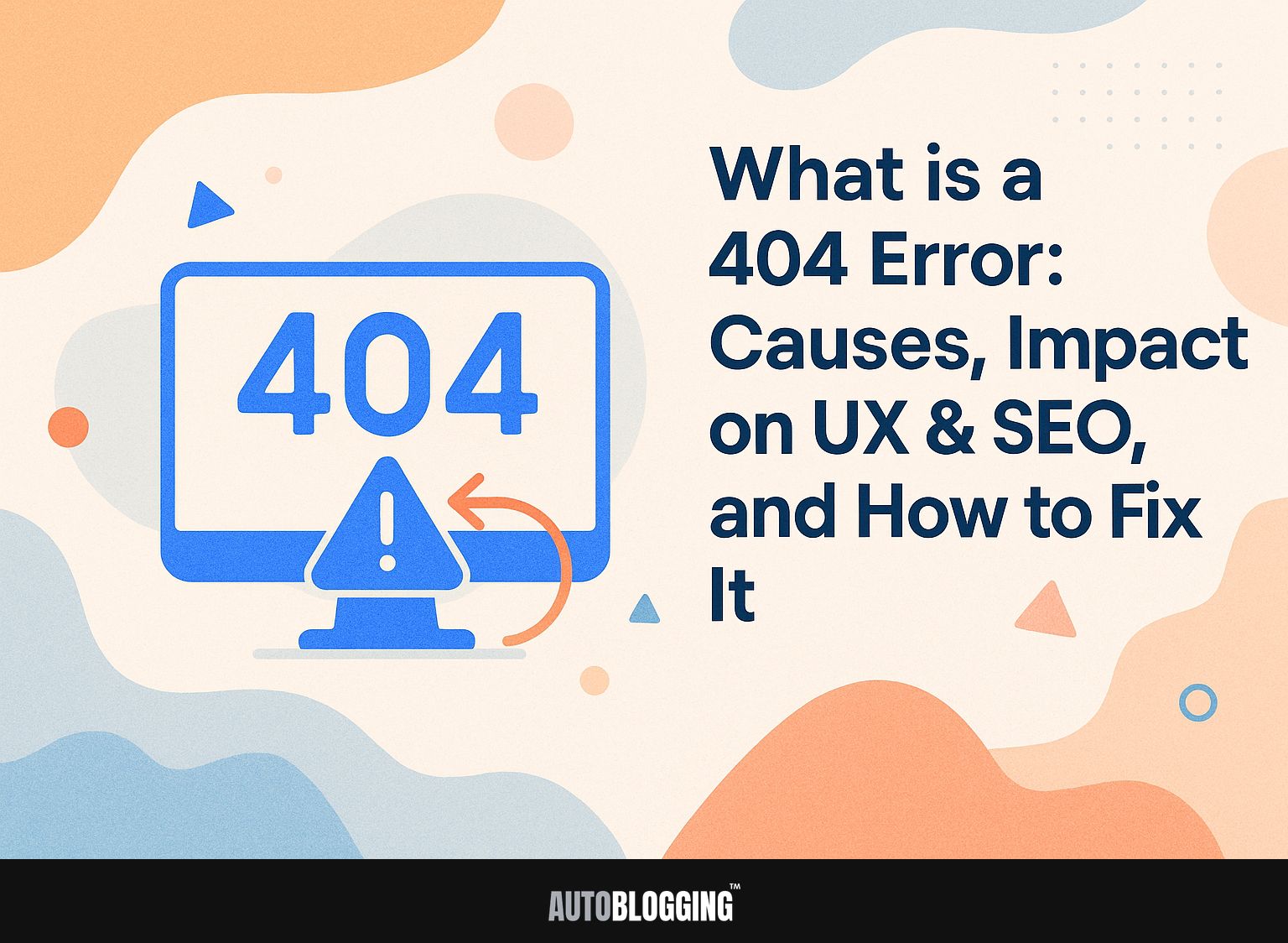
Encountering a 404 error can be frustrating for both users and website owners. This common issue arises from broken links or deleted content, directly impacting user experience and SEO. Tools like Google Search Console and Screaming Frog can help identify these errors. In this article, we’ll look into what causes 404 errors, how they affect users’ confidence and search engine results, and practical ways to fix them to improve your site’s function.
Key Takeaways:
- 404 errors can occur due to broken links, deleted or moved content, incorrect URLs, and server issues.
- These errors can have a significant impact on user experience, causing frustration, increased bounce rates, and loss of trust in the website.
- To fix 404 errors, it is important to regularly identify and redirect them, create a custom 404 page, and prevent them by maintaining a clean URL structure and educating content creators.
Contents
- Causes of 404 Errors
- Impact on User Experience (UX)
- Impact on Search Engine Optimization (SEO)
- How to Fix 404 Errors
- Preventing Future 404 Errors
- Frequently Asked Questions
- 1. What is a 404 Error and why does it occur?
- 2. What impact does a 404 Error have on UX and SEO?
- 3. How can I prevent 404 Errors from occurring?
- 4. How does a 404 Error impact website traffic and conversion rates?
- 5. What are some common ways to fix a 404 Error?
- 6. How can I use a 404 Error to my advantage?
1. Definition of a 404 Error
A 404 error happens when a web address can’t be found on a server, resulting in a ‘404 Not Found’ status code in HTTP responses. These errors are typically generated when a user tries to access a page that has been moved or deleted, or when a URL is entered incorrectly.
Common scenarios that lead to 404 errors include broken links on your website, outdated bookmarks, or mistyped URLs. For instance, if a blog post has been deleted but links to it still exist, users will encounter a 404 error.
Regularly monitoring your site with tools like Google Search Console can help identify broken links and improve user experience.
2. Common Misconceptions
Many believe that all 404 errors are the same, but distinctions between hard 404s and soft 404s can significantly impact SEO and user experience.
A hard 404 error indicates that the server cannot find the page, leading to a definitive ‘Not Found’ message. This type signals search engines to remove the URL from their index, which can harm your site’s SEO.
In contrast, a soft 404 occurs when a page displays as found but returns content that indicates the intended resource doesn’t exist, often leading to confusion among users and search engines.
Google Search Console can find these mistakes, so website owners can fix them quickly to improve site performance.
Causes of 404 Errors
Knowing why 404 errors happen helps you fix them and stop them from happening again, keeping the website running well.
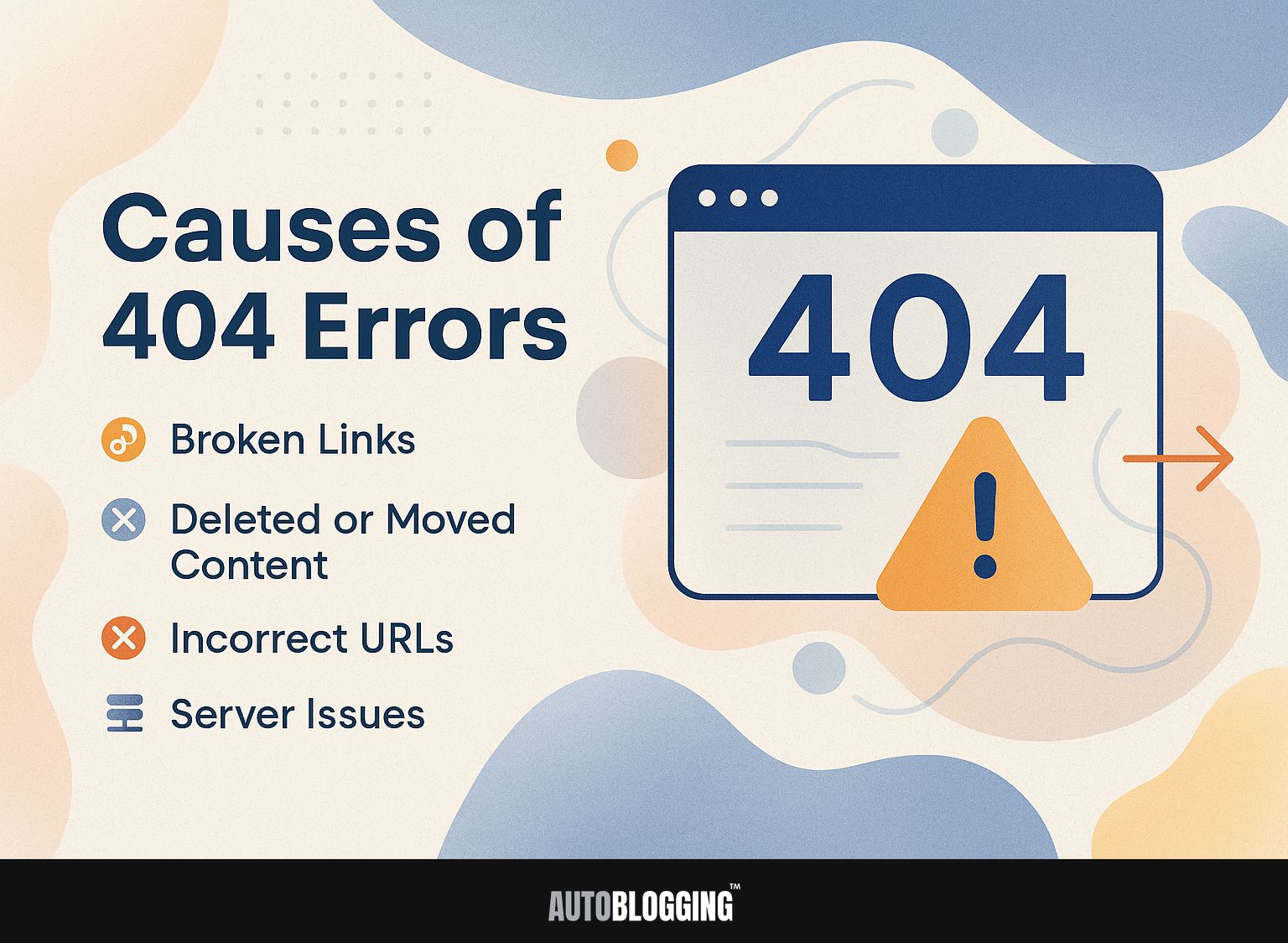
1. Broken Links
Broken links are one of the most common causes of 404 errors, occurring when a hyperlink points to a URL that no longer exists or is temporarily unavailable.
To tackle this issue effectively, begin by auditing your website for broken links. Use tools like Screaming Frog to look through your site for problematic URLs, or try Broken Link Checker, a free tool that scans your website and provides detailed reports.
Once identified, update these links to point to relevant and active content, or remove them if no alternative exists. Routine inspections can prevent upcoming issues, ensuring your site functions well for users.
2. Deleted or Moved Content
When content is deleted or moved without proper redirects, it can lead to 404 errors, affecting both user experience and site authority.
To mitigate these issues, implement 301 redirects for any changed or removed URLs. This notifies search engines that the content has permanently moved, preserving your site’s link equity.
If you remove a blog post about digital marketing trends, redirect that web address to another page with related information, such as a detailed guide on digital marketing.
Tools like Yoast SEO for WordPress or Redirection plugin can help with this task, allowing you to handle your redirects without needing deep technical skills. Regularly audit your site for broken links to maintain optimal performance.
3. Incorrect URLs
Incorrect URLs can lead users to 404 errors, often resulting from typographical errors or outdated bookmarks. To minimize 404 errors, implement regular link audits using tools like Screaming Frog or Ahrefs, which can identify broken links quickly.
Make sure all website links have a uniform structure by following good practices, like skipping extra parameters and using clear words.
Having a simple menu and a search tool helps users locate the pages they need quickly, cutting down on irritation.
Consider implementing a custom 404 page that guides users back to relevant content, thereby improving user experience despite errors.
4. Server Issues
Server issues, including downtime or misconfigurations, can intermittently generate 404 errors, hindering user access to content.
To tackle this problem, consistently check your website’s performance using tools like Google Search Console, which shows crawl errors and checks if the site is working properly.
Create alerts for major outages and use services like UptimeRobot to get instant notifications if your website goes offline.
Check the server settings in your hosting control panel to make sure they meet your website’s needs. Regularly testing your website’s links and performing periodic audits can help pinpoint and rectify potential sources of 404 errors.
Impact on User Experience (UX)
When users encounter 404 errors, it can make them unhappy and lead to losing trust in how dependable a website is. To delve deeper into this topic, our comprehensive guide on user experience best practices provides essential insights on maintaining a reliable and user-friendly website.
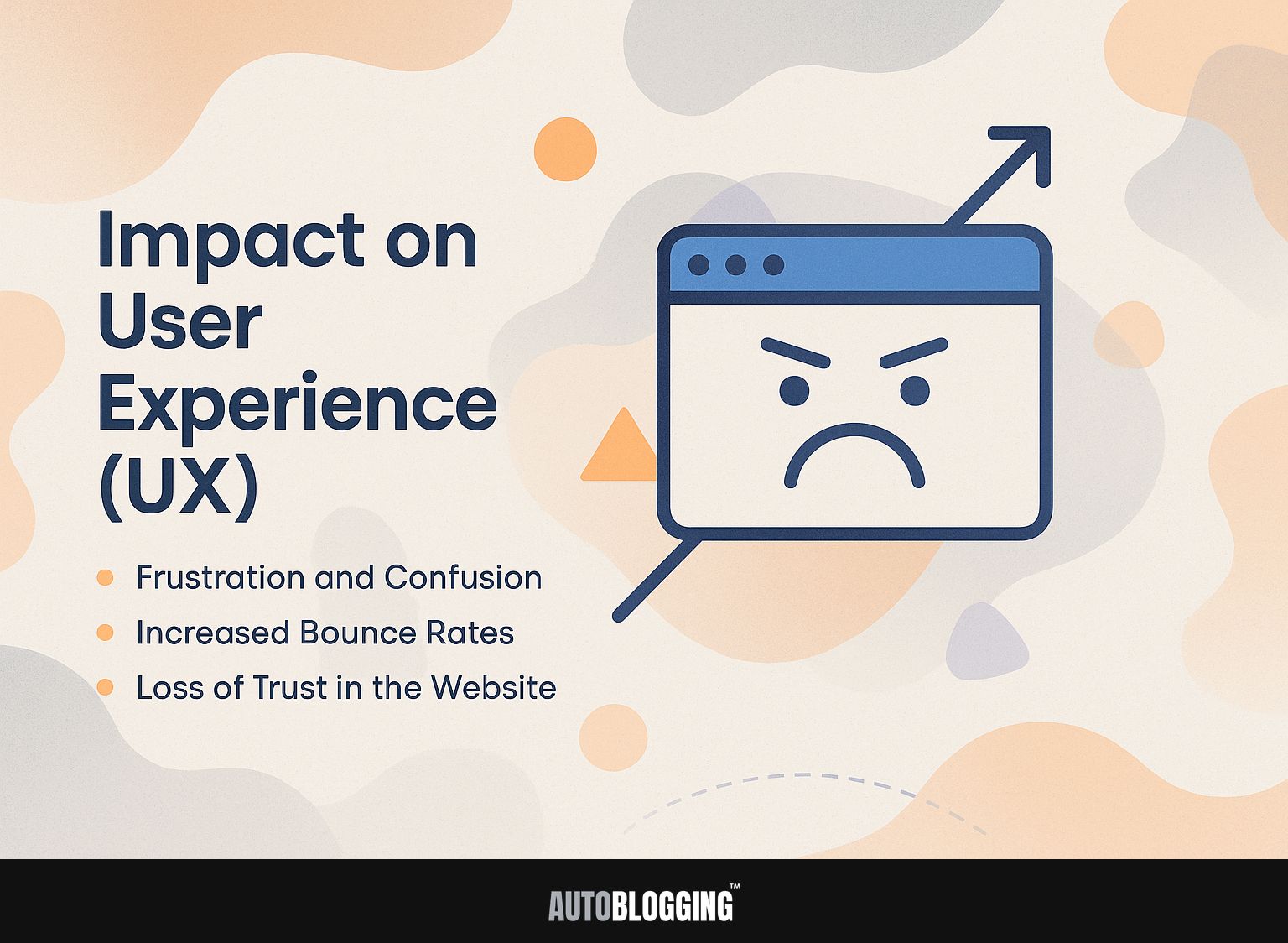
1. Frustration and Confusion
Encountering a 404 error can lead to immediate frustration and confusion for users, impacting their overall perception of the website. If not fixed, this issue may lead to losing potential customers.
A good approach is to make a special 404 page that says sorry and helps users find related content. For instance, include a search bar, links to popular articles, or a sitemap. Tools like Elementor or WordPress plugins can help design these pages without coding.
Think about setting up a redirect plan: if people frequently overlook a page, send them to a similar page to improve their experience.
2. Increased Bounce Rates
404 errors can lead to increased bounce rates, as users are likely to leave when they encounter a ‘page not found’ message.
Research shows that a 404 error can increase bounce rates by up to 50%. To mitigate this issue, regularly monitor your site’s health using tools like Google Search Console or Screaming Frog, which identify broken links.
Implementing a custom 404 page that guides users back to relevant content can also help; for example, include links to popular articles or a search bar.
Using breadcrumb navigation and a sitemap helps users keep their place and find the correct pages if they take a wrong turn.
3. Loss of Trust in the Website
Frequent 404 errors can erode user trust in a website, leading to perceptions of poor quality and negligence in site maintenance.
To regain trust, begin by carefully checking your site with tools such as Google Search Console or Screaming Frog SEO Spider to find and correct any broken links.
Talk openly with your users; think about creating a custom 404 page that says sorry and guides them to related content or ways to get in touch.
Regularly update your users about improvements and changes through newsletters or blog posts, emphasizing your commitment to maintaining a high-quality user experience.
Impact on Search Engine Optimization (SEO)
404 errors can negatively impact SEO by stopping search engines from crawling and indexing a site’s content correctly. To maintain a healthy SEO profile, it’s crucial to understand redirect strategies, such as using a 302 redirect, which can help manage link equity and user experience when pages are temporarily unavailable.
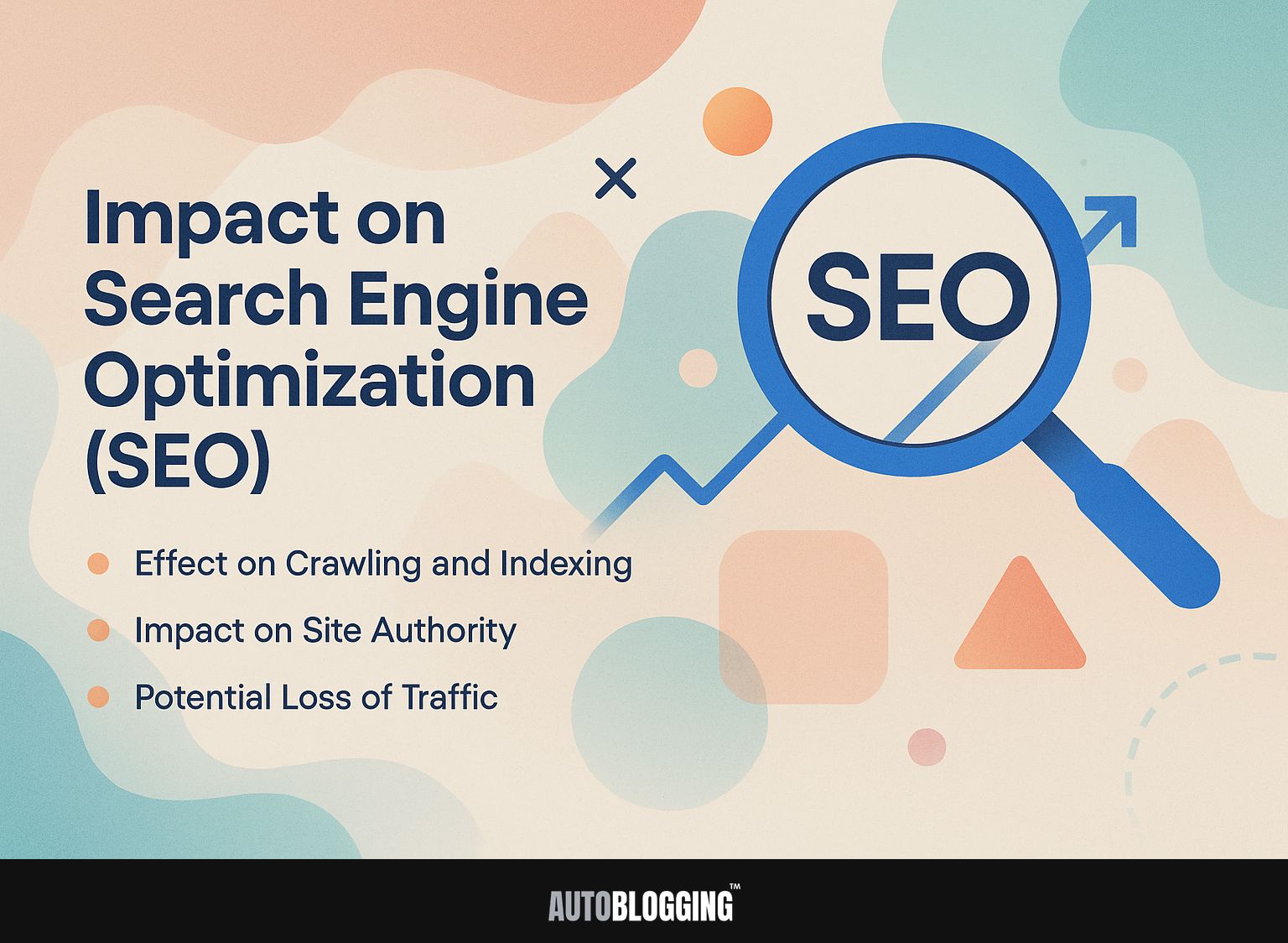
1. Effect on Crawling and Indexing
A high number of 404 errors can impede web crawlers, leading to inefficient crawling and negatively impacting indexing performance.
To mitigate this, regularly use Google Search Console to check your site’s indexing status. Monitor the ‘Coverage’ report where errors will be listed, allowing you to see which pages return 404s.
Once identified, take action by either updating the broken links to the correct URLs or redirecting them using 301 redirects. Tools like Screaming Frog can automatically find 404 errors on your site. Setting up a monthly review can greatly improve how well your site gets scanned.
2. Impact on Site Authority
Frequent 404 errors can diminish a website’s authority, as they indicate poor maintenance and can result in loss of link equity.
To recover lost link equity, start by identifying broken links using tools like Google Search Console or Screaming Frog. Once identified, implement 301 redirects to guide users and search engines to the correct pages.
For instance, if a blog post was deleted, redirect it to a relevant article or your homepage. Regularly audit your site to catch new errors early.
Using plugins like Redirection or Yoast SEO can make this process easier, helping your site stay in good standing with search engines.
3. Potential Loss of Traffic
404 errors can lead to considerable traffic loss, as users and search engines alike may abandon websites plagued by such issues.
For instance, a popular e-commerce site noticed a 20% drop in traffic after accumulating over 50 unresolved 404 errors. Users faced issues with non-working links when looking through product categories.
To address this issue, using tools such as Google Search Console can quickly find these mistakes. Utilizing a 301 redirect strategy can guide lost traffic back to relevant pages, significantly reducing potential losses.
Regular website audits are important. Look at your site each month to keep it running well and fix any broken links.
How to Fix 404 Errors
To fix 404 errors, follow a clear method by finding where the errors come from and applying suitable fixes. It’s beneficial to utilize tools like Google Search Console to track and analyze these errors effectively.
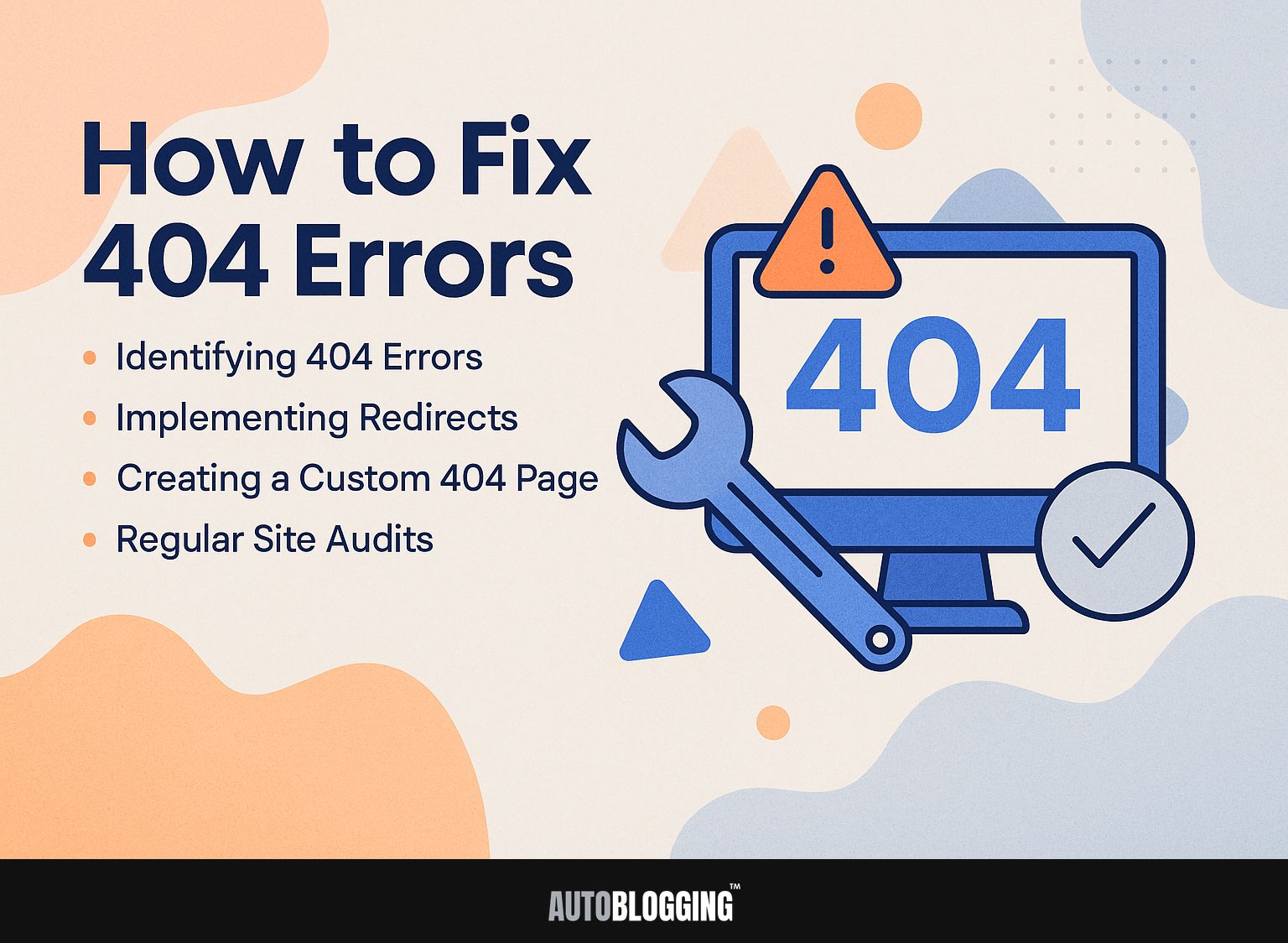
1. Identifying 404 Errors
You can easily find 404 errors by using tools such as Google Search Console and Screaming Frog to check your site for broken links.
Start by opening Google Search Console and go to the ‘Coverage’ report. There, you will see a list of found 404 errors. This tool highlights URLs that cannot be found, allowing you to take immediate action.
For thorough details on each link on your website, download and install Screaming Frog. Within Screaming Frog, you can run a site crawl and filter by response codes to isolate 404 errors, enabling quick remediation through redirects or content updates.
2. Implementing Redirects
Setting up 301 redirects is important for keeping link value and sending users from removed or relocated content to appropriate pages.
To set up 301 redirects, you can use an.htaccess file or a WordPress plugin like Redirection. If opting for.htaccess, add lines like
Redirect 301 /old-page.html http://yourwebsite.com/new-page.html
For WordPress, install Redirection, go to the plugin’s interface, and enter your old URL and the new destination. This approach maintains steady SEO rankings and improves user experience by ensuring they find the expected content.
Check your links often to avoid redirects and improve your site’s speed.
3. Creating a Custom 404 Page
A custom 404 page can help users by offering useful links and keeping the brand’s look, even when the page isn’t found. To make a helpful custom 404 page, start with an apology and make sure it’s clear for users.
Add a search bar so visitors can easily find what they need, and include links to popular or similar content on your site. Think about including a site map or menu to help users return to important sections.
Using engaging visuals that reflect your brand’s identity further softens the disappointment of encountering a missing page, ensuring visitors remain engaged rather than frustrated.
4. Regular Site Audits
Regularly checking your site helps find and fix 404 errors before they hurt user experience and SEO.
To maintain your website’s health, schedule audits quarterly. Use tools like Ahrefs to get a full report on your backlinks and Screaming Frog to check your site for broken links.
When using these tools, concentrate on creating reports that show both 404 errors and other problems like missing tags or pages that load slowly. This approach concentrates on resolving issues initially, ensuring your site remains user-friendly and increases its visibility on search engines, enhancing your online presence.
Preventing Future 404 Errors
To stop 404 errors from happening again, you need to take steps that keep URLs working and manage content well over time. If you’re interested, check out our insights on Link Decay 2023 and learn how it can affect your site’s performance.
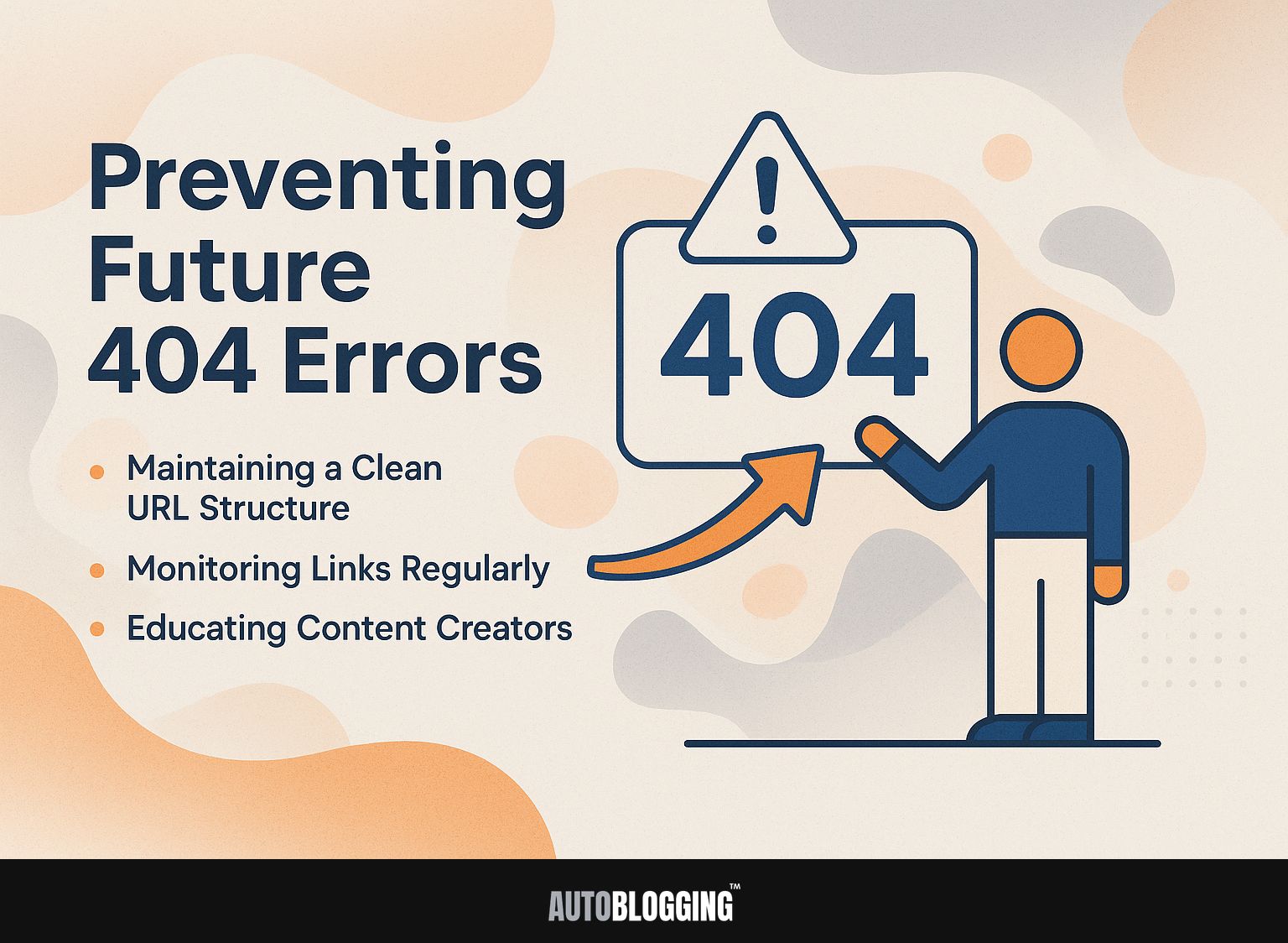
1. Maintaining a Clean URL Structure
Maintaining a clean URL structure helps prevent 404 errors by ensuring that URLs are logical, easy to read, and less likely to change.
To improve your URL structure, follow these best practices.
- First, use descriptive keywords; for example, instead of ‘example.com/page1’, use ‘example.com/seo-tips’. This enhances both readability and SEO.
- Next, stay away from URLs with long query strings, as they can confuse both users and search engines. Establish a consistent hierarchy by categorizing content clearly, such as ‘example.com/category/subcategory’.
This organized method makes it easier for users to find their way around and helps manage the site.
2. Monitoring Links Regularly
Regularly checking both internal and external links is important for quickly finding and fixing any broken links that could cause 404 errors.
To set up a good link checking process, use tools such as LinkChecker, which looks for broken links on your website automatically, or Ahrefs for a detailed check that also includes backlinks.
Schedule these scans weekly to identify issues early. Once a broken link is found, evaluate whether to update, redirect, or remove it.
Consider implementing a user feedback mechanism to allow visitors to report broken links, thus enhancing user satisfaction while keeping your site’s integrity intact.
3. Educating Content Creators
Educating content creators on proper URL management and the importance of link maintenance can significantly reduce the occurrence of 404 errors.
To implement an effective training program, start by emphasizing the significance of a consistent URL structure. Encourage creators to use descriptive, keyword-rich URLs that reflect page content.
Next, introduce tools like Google Search Console for monitoring broken links and redirecting old URLs using plugins like Redirection or Simple 301 Redirects.
Host monthly workshops where creators can share challenges and best practices in link management. Set up a regular schedule to go over content, updating old links and revising older articles to keep them useful and improve visitor interactions.
Frequently Asked Questions
1. What is a 404 Error and why does it occur?
A 404 Error is a type of HTTP status code that indicates a webpage or resource could not be found on a server. This can happen due to a variety of reasons such as broken links, deleted pages, or incorrect URL input.
2. What impact does a 404 Error have on UX and SEO?
A 404 Error can be frustrating for users and negatively impact their experience on a website. It can also affect SEO as search engines may reduce the website’s ranking if they encounter too many 404 errors. This is because it signals to the search engine that the website may have outdated or irrelevant content.
3. How can I prevent 404 Errors from occurring?
To prevent 404 Errors, regularly check for broken links on your website and fix them. It is also important to use proper redirects when changing page URLs or deleting pages. Also, regularly update your sitemap and send it to search engines so they can correctly list your website.
4. How does a 404 Error impact website traffic and conversion rates?
A 404 Error can cause people to leave a website because it prevents them from moving through the site. It can also negatively impact conversion rates as it can create a sense of untrustworthiness or confusion for potential customers.
5. What are some common ways to fix a 404 Error?
One way to fix a 404 Error is by creating a custom 404 page that provides a user-friendly message and suggests alternative resources or links. Another way is to set up redirects for broken or deleted pages to a relevant page on your website. You can also use tools like Google Search Console to identify and fix 404 errors on your website.
6. How can I use a 404 Error to my advantage?
You can use a 404 Error as an opportunity to engage with your users and improve their experience. By creating a custom 404 page with helpful information and links, you can turn a negative experience into a positive one and potentially keep users on your website. You can also use a 404 Error report to identify and fix any underlying issues with your website’s structure or usability.
